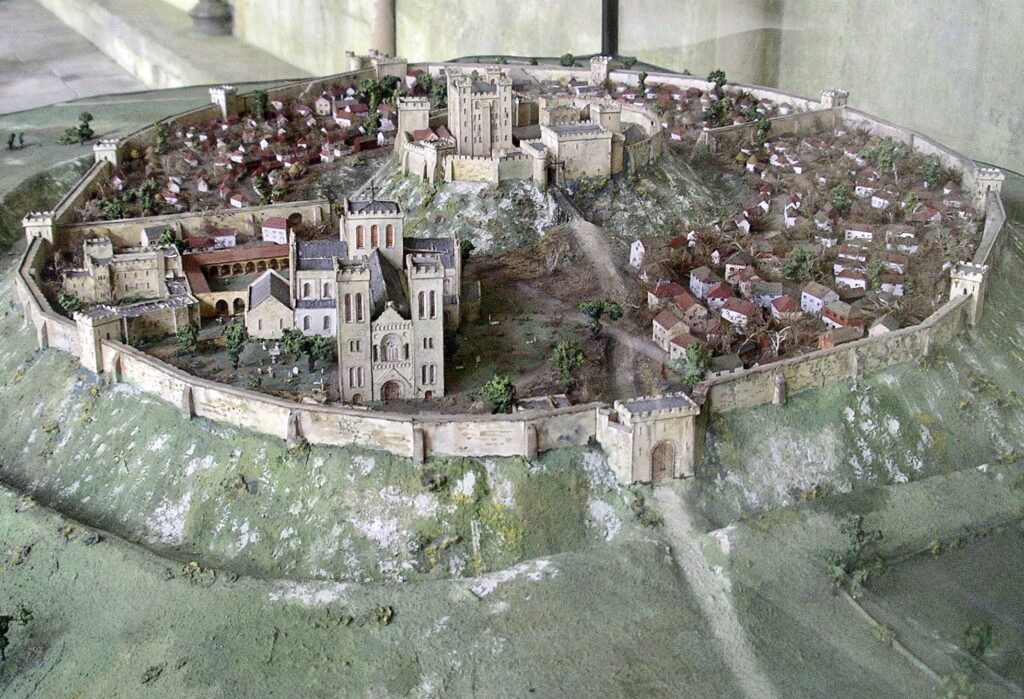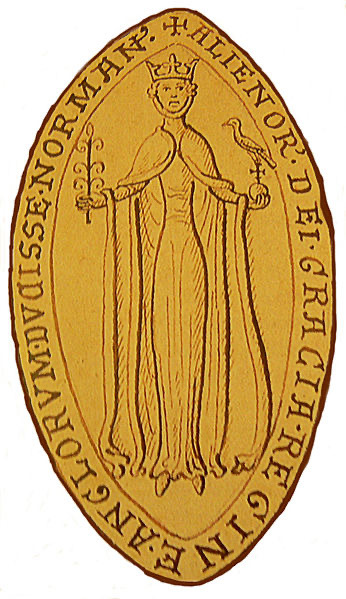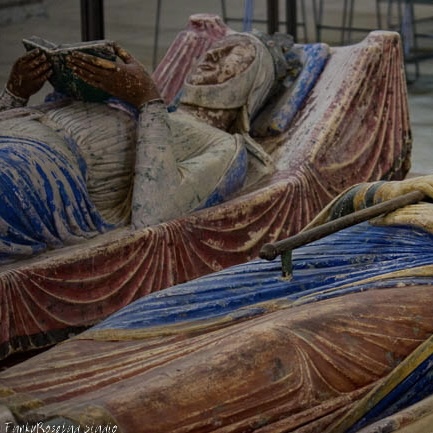Early life
Eleanor was born in 1122 in France, to Aénor of Châtellerault and William X, Duke of Aquitaine. When she was only 5 years old, she became her father’s heir presumptive.1 Eleanor was given a good education including literature, philosophy, and languages. When she came into her inheritance at 15, she became Duchess of Aquitaine and the first and only woman to rule her own duchy.2 In 1137 she married Louis VII who was the son of the King of France. Soon after they were crowned King and Queen of France. In 1147, Louis went to the Holy Land on a crusade3 and Eleanor persuaded him to allow her and her ladies to accompany him, which was unheard of at the time. It was a difficult journey and the crusade was unsuccessful, leading to a defeat in Damascus. There were also signs of marital problems between Eleanor and Louis. In 1152 the marriage was annulled, Eleanor regained Aquitaine, and Louis took custody of their two daughters (Marie and Alix of France).4 After the annulment, Eleanor married Henry, Count of Anjou, Duke of Normand. In 1154, Henry was crowned King Henry II of England, and Eleanor became Queen of England.5
Between 1153 and 1166, Henry and Eleanor had eight children (William IX, Henry the Young King, Matilda, Richard I of England, Geoffrey II, Duke of Brittany, Eleanor, Queen of Castile, Joan, Queen of Sicily, and John of England). The marriage was tumultuous, and Eleanor and Henry separated in 1167. Subsequently, from 1168-1173 Eleanor spent time in Poitiers. Here, it is said that she established the Court of Love, which was reportedly very influential in encouraging a culture of chivalry and courtly love.6 However the existence of the Court of Love has been debated by historians.

Rebellion and incarceration
In 1173 Eleanor was accused of supporting her son Henry’s revolt against the King as well as encouraging two of her other sons to get involved. However some historians argue that there was little evidence for this.7 At Poitiers, she was arrested and brought to England.
She spent the next 16 years under house arrest in various castles and strongholds in England including the strategically important Royal Castle of Sarum (now known as Old Sarum). There is very little information in the historical record about Eleanor’s activities during this time. Financial records from the period (mainly pipe rolls)8 show that expenditures were made on Eleanor’s behalf, but these have been interpreted by historians in various ways. Some historians suggest that she was in some comfort at Sarum, as records indicate that she had access to fine clothes and financial support from the Sherriff of Wiltshire (from 1175 to 1180), and money was spent on maintenance for her household (including chamberlains and maidens). In addition, improvements and fortifications were made to the castle while Eleanor was there.
She was still at Old Sarum in 1183, when her son the young King Henry became ill and on his deathbed begged for his mother’s freedom. When he died, Eleanor was sent the news, but reportedly said that she had already foretold his death in a dream. Subsequently, Eleanor seemed to be granted greater freedom: she was allowed to leave Old Sarum under guard, when King Henry summoned her to France for 6 months. She then returned to England. It seems that in this later period of her imprisonment she was occasionally allowed to join King Henry for her ceremonial duties as queen, although still under heavy supervision. In 1189 when Henry died, Eleanor was released. Their son Richard I9 became king.
Later life
Eleanor still held considerable political influence in her widowhood and later life, and continued to forge strong alliances between families, ensuring that her descendants continued to have power. For example, she was given responsibility for several strategically important missions such as accompanying Berengaria of Navarre, her future daughter-in-law and the future Queen of England, from Navarre to Sicily.10 When Richard gave Eleanor power over the English kingdom, she travelled around England releasing prisoners and receiving oaths of loyalty to the King. She was also present at various councils in England and in Normandy. Also, while Richard was leading the Third Crusade, Eleanor ruled as regent11 in his name. When Richard was imprisoned by the Holy Roman Emperor (Henry/Heinrich VI), she played a key part in raising the large ransom for his release. It has been suggested that when Eleanor’s youngest son John plotted to take over from Richard and aligned himself with King Phillip II of France, she acted to secure England and persuaded John not to continue with his plot.12
.

1199, Richard died, and John became King of England. He formed a truce with Phillip II of France and employed Eleanor as an envoy to choose one of her granddaughters, the princesses of Castile,13 to be married to Louis VIII of France (son and heir of Phillip II). Eleanor, now into her seventies, undertook the arduous journey to escort the princess on her journey to France, which included travel In across the Pyrenees. Some sources say that she was ambushed on her way to Castile, reportedly by the Lusignan brothers, but managed to negotiate with them so that she could proceed with her journey.14
Eleanor would later support John’s rule against the rebellion of her grandson Arthur of Brittany. In 1202 Arthur rebelled against John and besieged Eleanor in the Chateau de Mirebeau. Reportedly she tried to negotiate with him, and these delaying tactics led to his capture and imprisonment by John.15 Eleanor eventually retired to the abbey at Fontevraud, where she was buried upon her death in 1204.16
Like most medieval queens, Eleanor’s influence was very much dependent on her relationship with the king. However, far from being passive, she was extremely ambitious, and intensely involved in power politics. She governed nations, supported rebellion, and offered counsel to her sons in the final years of her long life, when most of her contemporaries had been dead for years. She also played an active part in ensuring her own legacy by forming strategic unions between families. In short, she was one of the most influential figures in 12th-century Europe.
Around 900 years since her birth, Eleanor’s legacy continues: she has been written about extensively by historians, although the accounts vary. As a powerful woman and monarch, it is perhaps unsurprising that she had her detractors and was the subject of salacious gossip, although in recent years historians have discredited many of the rumours about her. In her biography of Eleanor, Jane Martindale draws attention to the way that Eleanor’s political activities are not recognised in the same way as those of her husbands and sons. However Martindale argues that ‘…Eleanor did play a significant part in both the government and politics of her own world. Like her husbands and sons, when called to do so, she harnessed – and sometimes overrode- royal bureaucratic machinery to serve her own political ends’.
Over the centuries, Eleanor’s life has captured the imagination of countless artists and creators: for example, she has featured as a character in several novels, plays, dramas, operas, poetry, films, as well as being a character in a video game.17
Researched and written by Heather Sheeley and S.Ali
Notes
1 An heir presumptive is a person who is entitled to inherit a throne but their position may be displaced if, prior to the ancestor’s death, another person is born who has better claim to the position because they are a closer relative of the ancestor.
2 A duchy is the territory of a duke or duchess.
3 The crusades were a series of religious wars during the medieval period. The second crusade was led by King Louis VII of France and King Conrad III of Germany, and led to a defeat at Damascus.
4 Marie of France married Henry, Count of Champagne in 1164, and became Countess of Champagne. Alix of France married Count of Blois in 1164 and became Countess of Blois.
5 Henry was from the influential royal family named the House of Plantagenet. More information about them can be found here: https://www.britannica.com/topic/house-of-Plantagenet
6 Chivalry: the medieval system of knights (this also refers to the ideal social and moral codes and conduct of knights).
7 This is discussed further here: https://www.historyextra.com/period/medieval/eleanor-aquitaine-myths-about-medieval-queen-facts-who-mother/
8 More information about pipe rolls (and how to access them) can be found at the National Archives website: https://www.nationalarchives.gov.uk/help-with-your-research/research-guides/medieval-financial-records-pipe-rolls-1130-1300/
Some relevant pipe rolls
9 Known as Richard the Lionheart
10 Berengaria went on to marry Richard and was subsequently crowned Queen of England. This match was strategically important because of Navarre being next to Eleanor’s land in Aquitaine, which meant that the southern border of Aquitaine would be secured. More about Berengaria can be found at the following website: https://epistolae.ctl.columbia.edu/woman/79.html
11 Regent: a person who governs a kingdom if the monarch is not available, for example because of illness or disability.
12 Warren, W.L., 1991, King John. London: Methuen.
Martindale, Jane, 2004, Eleanor [Eleanor of Aquitaine], suo jure duchess of Aquitaine (c.1122-1204). https://doi.org/10.1093/ref:odnb/8618
13 Eleanor chose Blanche, who was only 12 at the time; as was Louis. The marriage led to a powerful union, linking the kings of France and England. Blanche herself grew up to become a powerful and influential queen of France.
14 Kelly, Amy, 1950, Eleanor of Aquitaine and the Four Kings. Harvard University Press. Erenow Biographies and Memoirs 18 The Grandmother of Europe https://erenow.net/biographies/eleanor-of-aquitaine-the-mother-queen-of-the-middle-ages/19.php
15 https://en.wikipedia.org/wiki/Arthur_I,_Duke_of_Brittany
16 Her bones were interred in the abbey’s crypt. However, they were later exhumed and dispersed when the abbey was desecrated during the French Revolution.
17 More information about how Eleanor has influenced popular culture can be found here: https://en.wikipedia.org/wiki/Eleanor_of_Aquitaine#Popular_culture
.
Bibliography
Archer, Thomas Andrew, 1900, Eleanor (1122?-1204) Dictionary of National Biography, 1885-1900, Volume 17. https://en.wikisource.org/wiki/Dictionary_of_National_Biography,_1885-1900/Eleanor_(1122%3F-1204)
BBC Radio 4. In Our Time. Eleanor of Aquitaine. Podcast. Released 28 Jan 2016. https://www.bbc.co.uk/programmes/b06yfhqk
BBC Sounds. Your Dead to Me Eleanor of Aquitaine Released 27 Mar 2020 https://www.bbc.co.uk/programmes/p087r8kb
Boyd, Douglas, 2011, April Queen: Eleanor of Aquitaine.
British History https://www.british-history.ac.uk/rchme/salisbury/pp1-24
Cockerill Sara. BBC History Magazine Revealed. The Real Eleanor of Aquitaine: 5 Myths about the medieval queen. https://www.historyextra.com/period/medieval/eleanor-aquitaine-myths-about-medieval-queen-facts-who-mother/
Erenow Biographies and Memoirs https://erenow.net/biographies/aprilqueeneleanorofaquitaine/15.php FOURTEEN p15
English Heritage Education. Teacher’s Kit. Old Sarum. https://www.english-heritage.org.uk/siteassets/home/learn/school-visits/free-school/teachers-kits/old-sarum-teachers-kit-2015.pdf
Grant Lindy English Heritage Past Lives: Eleanor of Aquitaine at Old Sarum Past Lives: Eleanor of Aquitaine at Old Sarum | English Heritage (english-heritage.org.uk)
History.Com Eleanor of Aquitaine. https://www.history.com/topics/british-history/eleanor-of-aquitaine
Kelly, Amy, 1950, Eleanor of Aquitaine and the Four Kings. Harvard University Press.
Les Milandes. Eleanor of Aquitaine. https://www.lesmilandes.com/blog/eleanor-of-aquitaine/
Martindale, Jane, 2004, Eleanor [Eleanor of Aquitaine], suo jure duchess of Aquitaine (c.1122-1204). https://doi.org/10.1093/ref:odnb/8618
McNamara, Jo Ann, and Suzanne Wemple, 1973,“The Power of Women through the Family in Medieval Europe: 500-1100.” Feminist Studies, vol. 1, no. 3/4. pp. 126–141. JSTOR, www.jstor.org/stable/1566483. Accessed 29 Dec. 2020
McNeil, John, English Heritage. History of Old Sarum. https://www.english-heritage.org.uk/visit/places/old-sarum/history/
Nelson, Janet L. Reynolds Susan and Johns Susan M. Gender and historiography Studies in the earlier middle ages. London Institute of Historical Research 2017
Podcast: Sara Cockerill and Dan Jones explore the life story of the remarkable medieval queen Eleanor of Aquitaine https://www.historyextra.com/period/medieval/eleanor-aquitaine-myth-reality-life-sara-cockerill-dan-jones-podcast/
Professor Lindy Grant Eleanor of Aquitaine: the medieval queen who took on Europe’s most powerful men HistoryExtra. BBC History Magazine and BBC History Revealed Eleanor Of Aquitaine: The Medieval Queen Who Took On Europe’s Men – HistoryExtra
The History Girls – Eleanor of Aquitaine. http://the-history-girls.blogspot.com/2016/08/eleanor-of-aquitaine-going-distance-by.html
The Ministry of History. Eleanor of Aquitaine- The Grandmother of Medieval Europe. https://www.theministryofhistory.co.uk/historical-biographies/eleanorofaquitaine
Thought Co. Eleanor of Aquitaine’s Children and Grandchildren. https://www.thoughtco.com/eleanor-of-aquitaines-children-and-grandchildren-3529605
TYLER, ELIZABETH M. From Palace to Prison “Conclusion: Endings and Beginnings.” England in Europe: English Royal Women and Literary Patronage, C.1000–C.1150, by University of Toronto Press, Toronto; Buffalo; London, 2017, pp. 354–366. JSTOR, www.jstor.org/stable/10.3138/j.ctt1whm96v.15. Accessed 6 Feb. 2021.
Turner, Ralph, 2009, Eleanor of Aquitaine, Queen of France, Queen of England. Yale University Press.
Weir, Alison, 2008, Eleanor of Aquitaine: By the Wrath of God, Queen of England. Random House.
Whiting, B. J. “Historical Novels: 1951.” Speculum, vol. 28, no. 3, 1953, pp. 527–554. JSTOR, www.jstor.org/stable/2847029. Accessed 30 Dec. 2020.
Women in History Eleanor of Aquitaine | English Heritage (english-heritage.org.uk)
Yale Books. Like Grandmother, like granddaughter: Eleanor of Aquitaine and Blanche of Castile. https://yalebooksblog.co.uk/2016/11/11/eleanor-of-aquitaine-and-blanche-of-castile/

